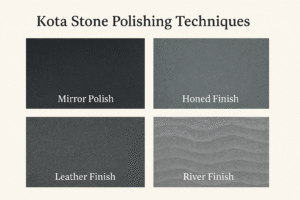Kota Stone Polishing Techniques
Kota stone is a fine-grained limestone, primarily sourced from Kota district in Rajasthan, India. Known for its durability and smooth surface, it is widely used in residential and commercial flooring. To enhance its aesthetic appeal and functionality, various polishing techniques are applied after installation or during processing. Each polishing method offers a distinct surface texture and finish suitable for different applications.
1. Mirror Polish (High Gloss Finish)
This technique involves multiple rounds of grinding and buffing using abrasive polishing pads. The final stage uses fine-grit diamond tools and polishing compounds to give the surface a reflective, mirror-like shine. Mirror polishing is popular for interior flooring, hotel lobbies, and showrooms, where high visual appeal is needed.
2. Honed Finish
A honed finish is achieved by using medium-grit abrasives that create a smooth, matte surface without the glossy shine of mirror polishing. This type of polish enhances the natural color of the stone while offering better slip resistance, making it ideal for bathrooms, balconies, and outdoor patios.
3. Leather Finish
The leather finish creates a soft-textured surface that is slightly rough to the touch but visually appealing. This is achieved through specialized brushes that give the surface a leathery appearance. It is commonly used for wall cladding, steps, and countertops, offering a mix of rustic and modern aesthetics.
4. River Finish (Brushed or Textured Polish)
River finish, also known as brushed finish, is done using hard nylon brushes that create a wave-like texture on the surface. This type of polish provides non-slip properties and is well-suited for wet areas, driveways, and pool decks.
5. Semi-Polished or Satin Finish
Semi-polishing is a midway technique that provides a light shine without the intense gloss of mirror polish. It is often used in institutional buildings, hospitals, and large corridors to balance aesthetics and functionality.
Conclusion
The selection of a polishing technique for Kota stone depends on the intended use, environmental conditions, and aesthetic preferences. Proper polishing not only enhances the stone’s appearance but also improves its performance in terms of stain resistance, maintenance, and durability.

